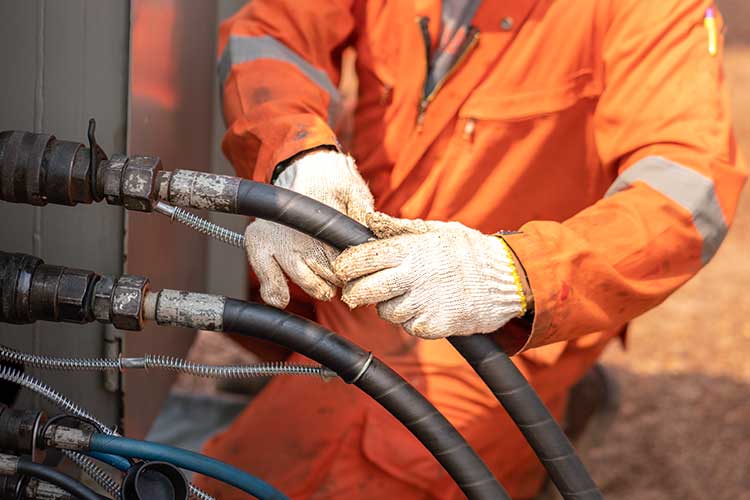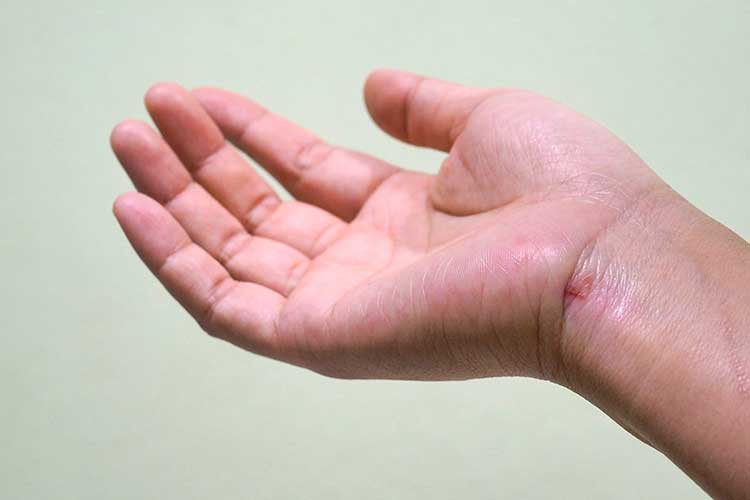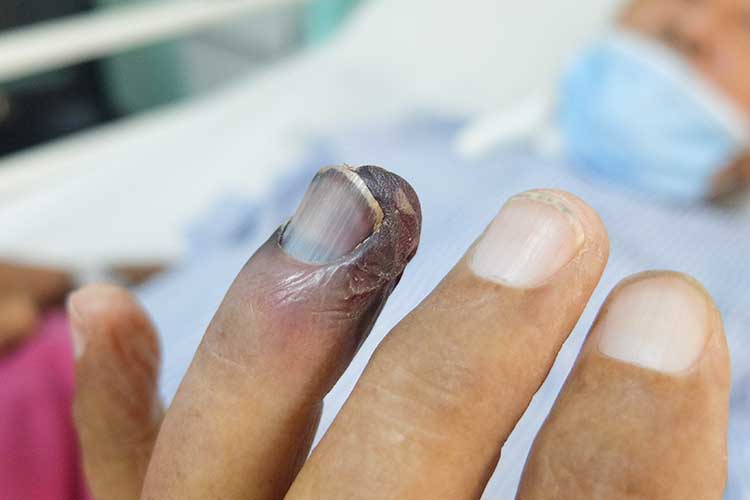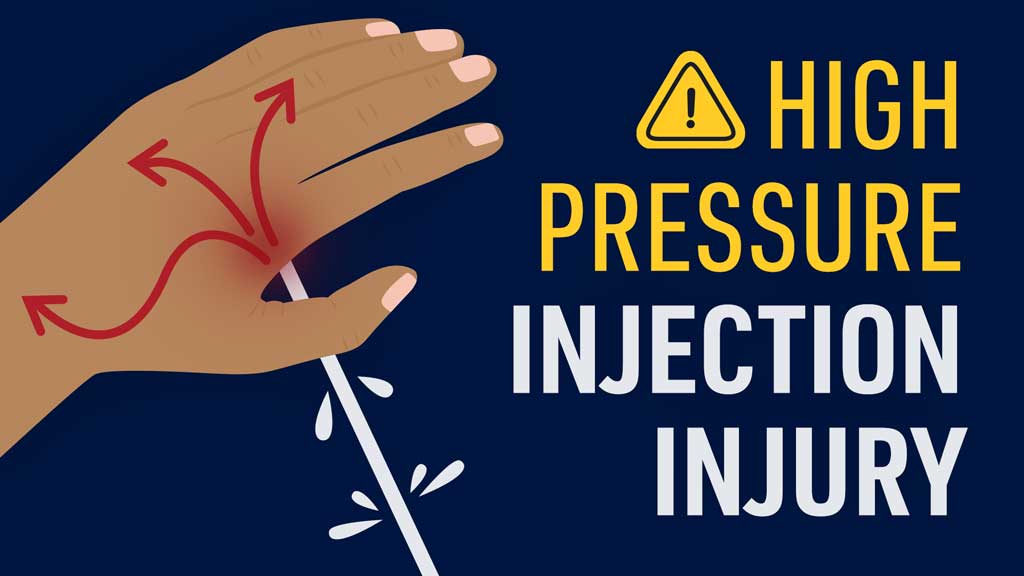High-pressure injection injuries, which occur when foreign material is accidentally injected into the skin via high-pressure industrial equipment, may resemble nothing more than a pin-sized hole (Nickson 2022).
However, despite their inconspicuous appearance, these injuries are a surgical emergency at best - and cause for amputation at worst (QAS 2021).
Why is such a benign-looking injury a limb-threatening medical emergency?
What is a High-Pressure Injection Injury?
High-pressure injection injuries, also known as hydraulic/fluid injection injuries, are puncture wounds caused by accidental injection of foreign material into the skin at high pressure (Healthwise Staff 2024).
Once injected, this material can reach as far as the forearm or upper arm, initially with no superficial evidence of the extent of the damage (Hadeed et al. 2023).
These injuries typically occur in occupational settings where high-pressure industrial equipment is used for tasks such as inoculating animals, painting, lubricating, greasing and cleaning (Nickson 2022). Examples of this equipment include:
- Hydraulic systems
- Paint spraying devices
- Grease guns
- Diesel fuel injectors
- Air compressors.
(Nickson 2022; Sydney Hand Surgery Clinic 2020; Hadeed et al. 2023)
Accidents involving high-pressure equipment are generally self-inflicted and usually occur while the device is in use or during tasks such as cleaning where the operator’s hand comes into contact with the nozzle. Often, the injury is caused by a leak in the device’s piping or an accidental misfire (Sydney Hand Surgery Clinic 2020; Hadeed et al. 2023).
Therefore, most injuries (about 75% of cases) involve the non-dominant hand (Sydney Hand Surgery Clinic 2020).
The body sites most likely to be injured are the index finger, palm and middle finger (Sydney Hand Surgery Clinic 2020).

Risk Factors for High-Pressure Injection Injury
Those who are at increased risk of high-pressure injection injury are:
- Young males, as they are most likely to be working with high-pressure industrial equipment
- People who have limited experience using high-pressure industrial equipment.
(Nickson 2022)
While these injuries predominantly affect labourers, there have been cases of paediatrics being wounded by high-pressure devices in the home (Tehrani et al. 2016).
Mechanism of Injury
The exact damage caused by the injury will depend on:
- The type, toxicity, temperature, and thickness of the fluid injected into the body. Examples of substances that may be injected include:
- Paint (60% of cases)
- Grease (25% of cases)
- Water
- Oil
- Diesel
- Paint thinner
- Animal vaccines
- Water
- Air
- The amount of fluid that was injected
- The part of the body that was injected
- The velocity at which the fluid was injected
- How long it takes the patient to receive treatment after the injury occurs
- The extent of the spread of the injected fluid into other tissue
- Individual risk factors.
(Nickson 2022; Healthwise Staff 2024; Sydney Hand Surgery Clinic 20; Hadeed et al. 2023)
Paint, paint solvent, paint thinner and fuel are the materials most likely to cause complications when injected (Healthwise Staff 2024; Sydney Hand Surgery Clinic 2020).
The process of injury can be divided into three phases:
- Direct mechanical impact
- Inflammatory response
- Secondary infection.
(Hadeed et al. 2023)
1. Direct Mechanical Impact
The pressure needed to penetrate human skin is about 100 psi (pounds per square inch) (Johnson Jr 2024). However, some high-pressure devices are capable of producing a force of up to 10,000 psi at 400 miles per hour. This amount of pressure is the same as 1,000 kg being dropped on the hand from a height of 25 cm (Hadeed et al. 2023).
When aimed at the body, this extreme pressure penetrates the skin, propelling the foreign material in a stream until it encounters resistance from a muscle or bone and rapidly disperses. In some cases, the foreign material can reach as proximally as the mediastinum (QAS 2021; Hadeed et al. 2023).
Upon dispersion, the foreign material travels along surrounding tissue pathways where neurovascular structures lie, damaging these structures and reducing perfusion to the affected area. This can lead to necrosis, which may require amputation (QAS 2021).
The presence of foreign material may also lead to tissue oedema, which puts extreme pressure on the surrounding blood vessels and hinders blood supply to the affected area. This can result in a type of compartment syndrome (QAS 2021).
2. Inflammatory Response
The extent of inflammation depends on the foreign material that has been injected. Certain substances, such as turpentine, are particularly cytotoxic, as they can dissolve fats and cause the liquefaction of body tissue. Other substances, such as grease and wax, are less inflammatory but can cause the formation of chronic granulomas, while water and air only have a minimal inflammatory response and are absorbed into the body over time (Hadeed et al. 2023).
3. Secondary Infection
In some cases, bacteria introduced into the body via the injected material can cause secondary microbial infection of the affected area. These bacteria may feed on necrotic tissue that has formed (Hadeed et al. 2023).
Diagnosis of High-Pressure Injection Injury

The site where the fluid penetrated the skin will typically resemble a pinhole-sized puncture, although in some cases, the point of entry is not visible at all (Nickson 2022; QAS 2021).
Initially, the patient may only present with numbness or increased pressure. Over the first four to six hours following the injury, the affected area may become swollen, painful, tense, cold and pale (Nickson 2022; QAS 2021; Johnson Jr 2024).
At this stage, clinicians may not recognise the severity of the injury due to its benign appearance, causing treatment to be delayed by several hours (Nickson 2022; QAS 2021).
Symptoms will progress in severity, eventually leading to throbbing pain in the affected area. Within only 12 hours, irreversible tissue necrosis will occur if the injury is left untreated (QAS 2021).
Therefore, taking the patient’s history upon presentation is essential in order to determine whether the wound is a high-pressure injection injury, and if so:
- The time of the injury
- How the injury occurred
- The device or machine involved
- The substance contained in the device
- The pressure magnitude of the device.
(Hadeed et al. 2023)
The patient will also need to undergo a physical exam in order to determine the proximal extent of the injury, assessing for range of motion, skin discolouration, pulse and neurologic function. A serial examination of the compartments should also be performed (Hadeed et al. 2023).
Other diagnostic tools that may be used include white blood cell count and imaging (Hadeed et al. 2023).
Treating High-Pressure Injection Injury
High-pressure injection injuries are emergencies and must be managed and treated as soon as possible (Nickson 2022).
In the event of a high-pressure injection injury, a variety of healthcare professionals will:
- Conduct a full head-to-toe patient assessment including neurovascular observations, vital signs and Glasgow Coma Scale (GSC).
- Administer pain relief.
- Assess the patient’s tetanus status and administer a tetanus booster if required.
- Administrate a broad-spectrum antibiotic with coverage for both gram-negative and gram-positive bacteria.
- Elevate and irrigate the affected area to remove large debris and allow for wound drainage. Avoid applying compressive dressings or closing the wound, as swelling will likely occur. Ice and digital blocks should also be avoided as they can reduce blood perfusion.
- Ensure the patient is promptly transferred to a trauma centre where surgery can be performed.
- Surgery should be performed as soon as possible and will involve debridement of the wound in order to remove the injected substance, manage inflammation, decompress the compartments and reduce the risk of long-term complications. The longer surgery is delayed, the greater the risk of morbidity and amputation.
- Surgical debridement may need to be repeated every 48 to 72 hours until all of the affected tissue and foreign material has been removed.
- Amputation may be indicated depending on clinical discretion and discussions with the patient.
(Hadeed et al. 2023; Nickson 2022)
High-pressure injuries where air, water or veterinarian vaccines were injected may be treated non-surgically by following steps 4 to 6 above. However, the patient must be closely observed and may require surgery later on if compartment syndrome or secondary infection occurs, or if non-surgical treatments are unsuccessful. Overall, 50% of all non-operative injuries will eventually require surgery (Hadeed et al. 2023; Johnson Jr 2024).
Prognosis of High-Pressure Injection Injury

Prognosis depends on a number of factors, but the most important indicator is the substance that was injected. Many injuries that undergo prompt debridement still require amputation, particularly those involving organic solvents such as turpentine, paint and fuel. Even with appropriate treatment, amputation rates for these substances may be as high as 80% (Hadeed et al. 2023; Nickson 2022).
On the other hand, injuries involving grease may only require amputation 20% of the time, and those involving non-cytotoxic substances (water or air) typically have the best prognosis (Hadeed et al. 2023).
Even if amputation isn’t indicated, many patients will experience lifelong functional impairment in the affected area, with complications such as chronic pain, hypersensitivity, paresthesias, motor dysfunction or contracture (Hadeed et al. 2023; Nickson 2022).
Postoperative Care of High-Pressure Injection Injury
Postoperatively, wound healing may be encouraged through the use of whirlpool therapy, wet-to-dry dressings, vacuum-assisted closure devices, and/or splinting. The patient may also undergo rigorous physical and occupational therapy to restore function in the affected area. If an amputation has been performed, the patient will require prosthetic training (Hadeed et al. 2023).
Test Your Knowledge
Question 1 of 3
Why should ice be avoided when treating high-pressure injection injuries?
Topics
Further your knowledge
References
- Hadeed, A, Anthony, J & Hoffler, C 2023, ‘Hand High Pressure Injury’, StatPearls, viewed 12 March 2025, https://www.statpearls.com/ArticleLibrary/viewarticle/22521
- Healthwise Staff 2024, High-Pressure Injection Wounds, University of Michigan Health, viewed 12 March 2025, https://www.uofmhealth.org/health-library/tm6523
- Johnson Jr, DB 2024, High-Pressure Injection Injuries, Ortho Bullets, viewed 12 March 2025, https://www.orthobullets.com/hand/12104/high-pressure-injection-injuries
- Nickson, C 2022, High Pressure-Injection Injury, Life in the Fast Lane, viewed 12 March 2025, https://litfl.com/high-pressure-injection-injury/
- Queensland Ambulance Service 2021, Clinical Practice Guidelines: Trauma/Fluid Injection Injury, Queensland Government, viewed 12 March 2025, https://www.ambulance.qld.gov.au/clinical/cpm/guidelines
- Sydney Hand Surgery Clinic 2020, High Pressure Injection Injuries, Sydney Hand Surgery Clinic, viewed 12 March 2025, https://www.sydneyhandsurgeryclinic.com.au/high-pressure-injection-injuries/
- Tehrani, N, Anoushiravani, AA, Bhakta, A, Pretrov, RV, Tafen, M, Samuels, S 2016, ‘Non-Operative Management of Water Injection Injury to the Neck’, Journal of Pediatric Surgery Case Reports, vol. 7, viewed 12 March 2025, https://www.sciencedirect.com/science/article/pii/S2213576616300094
 New
New 

